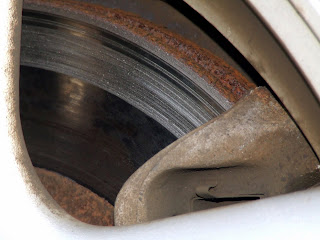As if I haven’t already mentioned it a multitude of times before . . . my husband is awesome. He’s a sweet, affectionate, intelligent and handy. He’s my personal Mr. Fix-it; plumbing, electrical, mechanical . . . he’s my handy man. He's my every man . . . he's awesome!
I drive a 1997 Honda CRV with over 160,000 miles on the odometer. It’s a great little car that serves me well and I love it.
I recently noticed that the front end was making noise . . . specifically; when I depressed the brake pedal . . . a grinding, scraping sound. So, I had hubby take a listen. He checked out my brakes and rotors and determined that they needed to be replaced . . . soon. He admonished me that I should have had some sort of warning that the brake pads were wearing down and instead of relatively inexpensive repair I now had a fairly expensive repair. Blah!
He can change out the brake pads and rotors himself but we live in a condo with no garage; which means he’d have to do the job working on the ground in a crowded parking lot. He was willing to pay someone $100 just so he wouldn’t have to do it himself. So, he asked me to call around and get some estimates on what it would cost to get my brakes done.
 I called around and it was going to cost me at least $350 to get new brakes and rotors put on my car. Hubby wasn’t about to spend that kind of money to do something that he could do for way less.
I called around and it was going to cost me at least $350 to get new brakes and rotors put on my car. Hubby wasn’t about to spend that kind of money to do something that he could do for way less.So, from my observations and endless questions is my interpretation of how to change the brake pads and rotors on my car.
The first thing he did was jack the car up off the ground so that he could remove the tire. That sounds easy enough until you take into consideration that my car is full of gardening stuff and the jack was buried in the wheel well under all that crap.
See that thingy-doodle up there? That's the caliper. What does it do? It calipates, what else! Actually, Brake calipers squeeze the brake pads against the surface of the brake rotor to slow or stop the vehicle. That had to come off next.
After removing the bolts he gently pried the caliper loose. Then he secured it with a bungee cord in order to keep from pulling on the brake line . . . he's so smart. :)
The caliper mounting bracket came off next.
And then the brake pads came off . . . the very worn out brake pads.
And then off with the rotor; which was a fairly difficult job since I don't think the rotors have been changed in the car's 15 years on the road. The bolts holding the rotor in place were pretty well rusted on. So he used a cool tool called an impact driver. An impact driver delivers a strong, sudden rotational and downward force. It is used to loosen larger screws (bolts) and nuts that are corrosively "frozen" or over-torqued. It's pretty spiffy.
Then it was time to install the shiny new rotors. They are packaged with lubrication to keep them from rusting on the shelf. So, he sprayed them with Brakleen . . . brake parts cleaner . . . to remove the oily coating. Slick brakes aren't a good thing.He also coated the bolts with caliper brake grease, which is a high temperature grease that is used to prevent corrosion.
Then the caliper mounting bracket went back on and the brake pads were prepped for installation.
He prepped them by smearing on Disc Brake Quiet. Disc Brake Quiet stops brake squeal by dampening vibration at caliper/brake pad interface. It also proveds a tighter fit and protects against corrosion.
 |
| Old pad on the left . . . new pad on the right |
Then the new "cushy" brake pads went on.
The caliper goes back on next. But before that can be done it needs to be compressed. But, some of the brake fluid should be suctioned out of the master cylinder first. Otherwise brake fluid will spill out all over the place when the caliper is compressed. Then using one of the old brake pads to protect the caliper and a C-clamp, he compressed the caliper.
Once the caliper was compressed, it was ready to be installed.
Then, finally, the tire went back on and . . .
. . . .tada . . . new brake pads and rotors.
But, he wasn't done quite yet. He checked the brake fluid to make sure the levels were good and then a quick test drive to make sure the brakes were functioning properly.
Yay! New brakes . . . for $100 he did what an auto shop would have charged over $350 dollars for.
Job well done, my sweet and awesome hubby! Smoochers!

















Well, your husband is right. You could’ve saved a lot from the repairs had you noticed the damage on your brake pad when it initially occurred. Small problems can escalate to bigger ones if not attended to immediately. Good thing he could take care of your brakes. And I can see that you enjoyed being the photographer to document the whole process. This is probably the most comprehensive documentation on replacing brake rotors and pads that I’ve ever seen. Thanks for the treat!
ReplyDeleteEnoch Ross